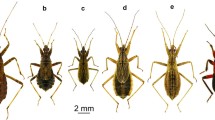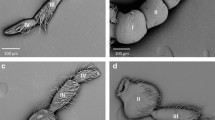Summary
-
1.
Poreless sensilla (np-sensilla) on the antennae of 18 species from 9 insect orders, and on the maxillary palps of Periplaneta americana were investigated using chemo- and cryofixation.
-
2.
The number of np-sensilla is low. Common features of these sensilla are: (a) the presence of a peg, (b) the lack of pores that lead to the dendritic outer segments (DOS), (c) the lack of socket structures, which would indicate flexibility, and (d) the presence of three types of sensory cells. The type-1 sensory cells are characterized by large DOS, which proceed into the peg where they fit tightly to its wall. As a rule, two DOS are present, being arranged in bilateral symmetry. Within them, in two species, a pattern of microtubules similar to that of a tubular body was observed. In the type-2 sensory cells, the DOS end beneath the peg and mostly display membrane invaginations. In the type-3 sensory cell, the DOS is an unmodified 9×2+0 cilium.
-
3.
Electrophysiological investigation of the np-sensillum in the maxillary palp of Periplaneta showed the presence of a hygroand/or thermoreceptor.
-
4.
In a comparison of np-sensilla with an inflexible socket in different insect species, it is shown that these sensilla represent one fundamental sensillum type and that their structural features can be regarded as adaptations to hygroand thermoreception.
Similar content being viewed by others
References
Altner H (1977a) Insect sensillum specificity and structure: an approach to a new typology. In: Le Magnen J, MacLeod P (eds) Olfaction and taste VI. Information Retrieval, London, pp 295–303
Altner H (1977b) Insektensensillen: Bau- und Funktionsprinzipien. Verh Dtsch Zool Ges 70:139–153
Altner H, Prillinger L (1980) Ultrastructure of invertebrate chemo-, thermo- and hygroreceptors and its functional significance. Int Rev Cytol 67:69–139
Altner H, Thies G (1973) A functional unit consisting of an eversible gland with neurosecretory innervation and a proprioreceptor derived from a complex sensillum in an insect. Z Zellforsch 145:503–519
Altner H, Ernst K-D, Kolnberger I, Loftus R (1973) Feinstruktur und adäquater Reiz bei Insektensensillen mit Wandporen. Verh Dtsch Zool Ges 66:48–53
Altner H, Sass H, Altner I (1977) Relationship between structure and function of antennal chemo-, hygro-, and thermoreceptive sensilla in Periplaneta americana. Cell Tissue Res 176:389–405
Altner H, Tichy H, Altner I (1978) Lamellated outer dendritic segments of a sensory cell within a poreless thermo- and hygroreceptive sensillum of the insect Carausius morosus. Cell Tissue Res 191:287–304
Altner H, Routil Ch, Loftus R (1981) The structure of bimodal chemo-, thermo- and hygroreceptive sensilla on the antenna of Locusta migratoria. Cell Tissue Res 215:289–308
Altner H, Loftus R, Schaller-Selzer L, Tichy H (1983) Modality-specificity in insect sensilla and multimodal input from body appendages. Fortschr Zool 28: (in press)
Becker D (1978) Elektrophysiologische Untersuchungen zur Feuchterezeption durch die styloconischen Sensillen bei Mamestra brassicae L. (Lepidoptera, Noctuidae). Doctoral Disertation, Univ Regensburg
Bernard J (1974) Étude électrophysiologique de récepteurs impliqués dans l'orientation vers l'hôte et dans l'acte hémaphage chez un Hémiptère: Triatoma infestons. Thèse, Université de Rennes
Boeckh J, Kaissling K-E, Schneider D (1960) Sensillen und Bau der Antennengeißel von Telea polyphemus. Zool Jahrb Anat 78:559–584
Corbière-Tichané G (1971) Structure nerveuse énigmatique dans l'antenne de la larve du Speophyes lucidulus Delar (Coléoptère cavernicole de la sous-famille des Bathysciinae). J Microscopic 10:191–202
Corbière-Tichané G (1973) Sur les structures sensorielles et leurs fonctions chez la larve de Speophyes lucidulus. Ann Spéléol 28:247–265
Corbière-Tichané G (1974) Fine structure of an antennal sensory organ (“vesicle olfactive”) of Speophyes lucidulus Delar (cave coleoptera of the Bathysciinae subfamily). Tissue and Cell 6:535–550
Corbière-Tichané G (1977) Étude comparative au microscope électronique de la “vésicle olfactive” des Catopidae cavernicoles (Coléoptères) Ann Sci Nat Zool Paris ser 12, 19: 89–110
Corbière-Tichané G, Bermond N (1972) Sensilles énigmatiques de l'antenne de certains Coléoptères. Z Zellforsch 127:9–33
Davis EE, Sokolove PhG (1975) Temperature responses of antennal receptors of the mosquito, Aedes aegypti. J Comp Physiol 96:223–236
Dietz A, Humphreys WJ (1971) Scanning electron microscopic studies on antennal receptors of the worker honey bee, including sensilla campaniformia. Ann Entomol Soc Am 64:919–925
Gaffal KP, Tichy H, Theiss J, Seelinger G (1975) Structural polarities in mechanosensitive sensilla and their influence on stimulus transmission (Arthropoda). Zoomorphologie 82:79–103
Glauert AM (1974) Fixation, dehydration and embedding of biological specimens. In: Glauert AM (ed) Practical methods in electron microscopy vol 3. North-Holland/Elsevier, Amsterdam Oxford New York, pp 1–3
Hallberg E (1980) Antennal sensilla of a noctuid moth. In: van der Starre H (ed) Olfaction and Taste VII. Information Retrieval, London, p 189
Harbach RE, Larsen JR (1977) Humidity behaviour and the identification of hygroreceptors in the adult mealworm, Tenebrio molitor. J Insect Physiol 23:1121–1134
Henke K (1953) Über Zelldifferenzierung im Integument der Insekten und ihre Bedingungen. J Embryol Exp Morphol 1: 217–226
Jez DH, McIver SB (1980) Fine structure of antennal sensilla of larval Toxorhynchites brevipalpis Theobald (Diptera: Culicidae). Int J Insect Morphol Embryol 9:147–159
Lawrence PA (1966) Development and determination of hairs and bristles in the milkweed bug Oncopeltus fasciatus (Lygaeidae, Hemiptera). J Cell Sci 1: 475–498
Loftus R (1966) Cold receptor on the antenna of Periplaneta americana. Z Vergl Physiol 52:380–385
Loftus R (1968) The response of the antennal cold receptor of Periplaneta americana to rapid temperature changes and to steady temperature. Z Vergl Physiol 59:413–455
Loftus R (1976) Temperature-dependent dry receptor on antenna of Periplaneta. Tonic response. J Comp Physiol 111: 153–170
Loftus R, Corbière-Tichané G (1981) Antennal warm and cold receptors of the cave beetle, Speophyes lucidulus Delar, in sensilla with a lamellated dendrite. I. Response to sudden temperature change. J Comp Physiol 143:443–452
McIver SB (1973) Fine structure of antennal sensilla coeloconica of culicine mosquitoes. Tissue and Cell 5:105–112
McIver SB (1975) Structure of cuticular mechanoreceptors of arthropods. Ann Rev Entomol 20:381–397
McIver S, Siemicki R (1976) Fine structure of the antennal tip of the crabhole mosquito, Deinocerites cancer (Diptera: Culicidae). Int J Insect Morphol Embryol 5:319–334
McIver S, Siemicki R (1979) Fine structure of antennal sensilla of male Aedes aegypti (L). J Insect Physiol 25:21–28
Nijhout HF, Sheffield HG (1979) Antennal hair erection in male mosquitoes: A new mechanical effector in insects. Science 206:595–596
Reimer L (1967) Elektronenmikroskopische Untersuchungs- und Präparationsmethoden. (2nd ed) Springer, Berlin Heidelberg New York
Steinbrecht RA (1980) Cryofixation without cryoprotectants. Freeze substitution and freeze etching of an insect olfactory receptor. Tissue and Cell 12:73–100
Steinbrecht RA, Müller B (1976) Fine structure of the antennal receptors of the bed bug, Cimex lectularius L. Tissue and Cell 8:615–636
Thurm U (1964) Mechanoreceptors in the cuticle of the honey bee. Fine structure and stimulus mechanism. Science 145:1063–1065
Thurm U (1965) An insect mechanoreceptor. I. Fine structure and adequate stimulus. Cold Spring Harbor Symp Quant Biol 30:75–82
Thurm U (1974) Mechanisms of electrical membrane responses in sensory receptors, illustrated by mechanoreceptors. In: Jaenicke L (ed) Biochemistry of sensory functions, Springer, Berlin Heidelberg New York, pp 367–390
Thurm U (1982) Mechano-elektrische Transduktion. In: Hoppe W, Lohmann W, Markl H, Ziegler H (eds) Biophysik (2nd ed) Springer, Berlin Heidelberg, pp 691–696
Thurm U, Küppers J (1980) Epithelial physiology of insect sensilla. In: Locke M, Smith DS (eds) Insect biology in the future, Academic Press, New York, pp 735–763
Tichy H (1979) Hygroand thermoreceptive triad in antennal sensillum in the stick insect, Carausius morosus. J Comp Physiol 132:149–152
Tominaga Y, Yokohari F (1982) External structure of the sensillum capitulum, a hygroand thermoreceptive sensillum of the cockroach, Periplaneta americana. Cell Tissue Res 226:309–318
Yokohari F (1978) Hygroreceptor mechanism in the antenna of the cockroach Periplaneta. J Comp Physiol 124:53–60
Yokohari F (1981) The sensillum capitulum, an antennal hygroand thermoreceptive sensillum of the cockroach, Periplaneta americana L. Cell Tissue Res 216:525–543
Yokohari F, Tateda H (1976) Moist and dry hygroreceptors for relative humidity of the cockroach, Periplaneta americana L. J Comp Physiol 106:137–152
Yokohari F, Tominaga Y, Ando M, Tateda H (1975) An antennal hygroreceptive sensillum of the cockroach. J Electron Micr 24:291–293
Yokohari F, Tominaga Y, Tateda H (1982) Antennal hygroreceptors of the honey bee, Apis mellifera L. Cell Tissue Res 226:63–73
Author information
Authors and Affiliations
Additional information
Supported by the Deutsche Forschungsgemeinschaft (SFB 4: G1)
Rights and permissions
About this article
Cite this article
Altner, H., Schaller-Selzer, L., Stetter, H. et al. Poreless sensilla with inflexible sockets. Cell Tissue Res. 234, 279–307 (1983). https://doi.org/10.1007/BF00213769
Accepted:
Issue Date:
DOI: https://doi.org/10.1007/BF00213769




